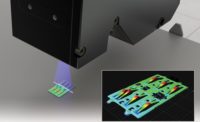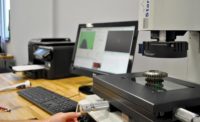
The OBV Scan System is integrated into the insulation glass production line. Source: Vision Components
Because the market for insulation glass is highly competitive, customers are guaranteed replacement glass panels even when there is only a small flaw. Manufacturers face high transport and replacement costs, particularly if the defect is only identified after delivery. Additionally, undue waiting times may displease customers. Therefore, reliable, fully automated in-production quality control is highly desirable. Up to now, glass inspection has usually been performed manually because previous machine vision solutions did not meet the requirements or were too costly. This problem can be solved by means of a new testing station developed by the Berlin-based company OB Vision, which can be integrated into insulation glass production lines.
The Challenge
Insulation glass consists of two or more plate glass panes connected by spacers. After single glass panes have been cut to size, workers optically check them for scratches, defective coating, bubbles, enclosures and soiling; for large panes, the staff even has to climb ladders. This time-consuming procedure does not guarantee consistent quality, and depending on worker experience, more or less flawed panes may pass to the next workstation. In the manufacture of insulation glass, it is imperative to detect defects as early as possible-in many cases, defects can be mended and the manufacturing process can be improved.OBV Scan System
The OBV Scan System is suitable for direct integration into any insulation glass production line between the washer and the visual inspection station. The only necessary adjustment is the installation of a lighting background. The system’s basic components are a compact scanning unit and an external display in the visual inspection station. Depending on the required height of the scanning unit, it is fitted with six to 12 VCSBC4018-type board cameras from Vision Components (Ettlingen, Germany). Additional equipment includes lighting and a sensor system to detect pane position. A connected PC for data memory and visualization recomposes the frames recorded by the separate cameras into a complete image of the inspected glass pane. The system keeps up with the production line’s maximum speed of about one meter per second.The display is integrated into the visual inspection station and shows a colored image of the current glass pane. Flawless glass surfaces are displayed in green, while irregularities are marked in different colors, such as red for heavy scratches or coating defects, yellow for light scratches, violet for bubbles, and blue for uneven breaking edges. Thus, operators can immediately identify defective panes. The fault tolerance can be fine-tuned according to operator requirements. The system is started by pushing a button, ready to operate within a short time and runs automatically. Requiring only minimal instruction, the system can be operated by untrained personnel.
The OBV Scan System enables remote quality control; all error images and data-defect frequency and type, pane size, cycle time and production output-are saved and can be made available for the company network via Ethernet, enabling statistical evaluation. For example, it becomes possible to assign error bursts to a particular time of day and to take countermeasures. Optionally, the scanning system is available in a version that saves all recorded production data in a table, analyzes the data and generates a graphic display.

Intelligent cameras from Vision Components can operate as stand-alone image processing systems, replacing conventional PC stations. Source: Vision Components
Scanning System in Practice
The first prototype of the OBV Scan System is the product of a two-year collaboration of the German companies OB Vision and Oder-Glas GmbH (Müllrose, Germany). The system has been customized to suit the manufacturer’s requirements. For more than one year, it has proven itself in everyday production, ensuring that no defective glass panes are delivered to customers.“Other available testing systems did not meet our requirements, so we were skeptical in the beginning,” says Christian Dahlick, chief executive officer of Oder-Glas GmbH. “But the OBV Scan System has convinced us, providing reliable defect detection. Together with OB Vision, we have defined exactly which defects must be displayed, and thus could considerably improve the detection rate. The quality of our delivered glass panes is now consistently high. In effect, we have minimized the return rate, which we could not have achieved with conventional, manual control methods.”
Transparency Pays Off
The scanning system is based on intelligent board cameras from Vision Components. “Testing stations in the production of insulation glass can only be implemented using extremely powerful camera systems-first, because the environment is very dusty, which means that PC-based systems are out of the question because they need fans, and, second, because large amounts of data must be processed in a short time,” says Steffen Grossert, developer and chief executive officer of OB Vision. “VC Smart Cameras are optimally suited for these requirements: their digital signal processors perform even demanding tasks. VC Cameras have another crucial advantage over most commercially available machine vision solutions: they can be freely programmed in C and C++. This way, we can customize application programs and implement modifications when needed.” Because the cameras are easily exchangeable, the OBV Scan System can be quickly repaired, making it a very flexible solution.Vision Components
(603) 598-2588
www.vision-components.com.

